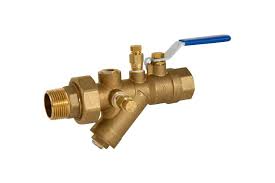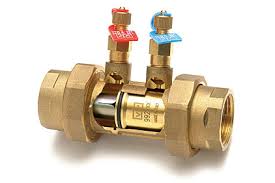Automatic Balancing Valve Working Principle

The Application of Automatic Balancing Valve
Flowserve Automatic Balancing Valve utilizes an innovative automatic balancing valve working principle to maintain optimal flow rates in HVAC systems. These valves, such as the Flowserve Automatic Balancing Valve, are designed to automatically adjust flow rates based on system demands, ensuring efficient and consistent performance. By dynamically adjusting flow rates, automatic balancing valves optimize system operation, minimize energy consumption, and prevent issues like uneven heating or cooling. With their advanced design, automatic flow balancing valves offer precise control over flow rates, maintaining system balance and eliminating the need for manual adjustments. Flowserve Automatic Balancing Valve provides reliable solutions for HVAC applications, ensuring optimal performance and energy efficiency.
What Is Automatic Balancing Valve ?
Automatic Balancing Valve is a specialized valve used in HVAC systems to automatically regulate flow rates and maintain hydraulic balance. These valves employ sophisticated mechanisms to adjust flow rates based on system conditions, ensuring consistent performance and energy efficiency. By dynamically balancing flow throughout the system, Automatic Balancing Valves optimize heating, ventilation, and air conditioning processes, providing reliable and efficient operation.
How Does Automatic Balancing Valve work?
Automatic Balancing Valve works by utilizing a self-regulating mechanism to adjust flow rates according to system demand. These valves typically incorporate a differential pressure control element that reacts to changes in flow conditions. When flow rates deviate from the desired setpoint, the valve modulates its opening to maintain the preset flow rate. This dynamic adjustment ensures hydraulic balance within the system, optimizing performance and energy efficiency.
Features of Automatic Balancing Valve
- Self-Regulating: Automatic Balancing Valves feature self-regulating mechanisms that adjust flow rates automatically based on system demand, ensuring optimal performance without manual intervention.
- Hydraulic Balance: These valves maintain hydraulic balance within HVAC systems by equalizing flow rates across different branches or circuits, preventing issues like uneven heating or cooling.
- Energy Efficiency: By dynamically adjusting flow rates, Automatic Balancing Valves optimize system efficiency, reducing energy consumption and operational costs.
- Precision Control: These valves offer precise control over flow rates, allowing for fine adjustments to match changing system conditions and requirements.
- Compact Design: With a compact and space-saving design, Automatic Balancing Valves are suitable for installations with limited space, providing flexibility and ease of integration into HVAC systems.
Advantages of Automatic Balancing Valve
- Efficient System Operation: Automatic Balancing Valves ensure efficient operation of HVAC systems by maintaining hydraulic balance and optimizing flow rates, leading to improved overall performance.
- Energy Savings: By automatically adjusting flow rates to match system demand, these valves help reduce energy consumption, resulting in lower operating costs and increased energy efficiency.
- Minimized Manual Adjustments: With their self-regulating capabilities, Automatic Balancing Valves minimize the need for manual adjustments, saving time and labor during installation and operation.
- Preventive Maintenance: These valves contribute to the longevity of HVAC equipment by preventing issues such as uneven heating or cooling, which can lead to premature wear and tear on system components.
- Flexibility and Adaptability: Automatic Balancing Valves are versatile and adaptable to various HVAC system configurations, offering reliable performance across a range of applications and operating conditions.

The Specifications of Automatic Balancing Valve
| Specification | Description |
|---|---|
| Type | Automatic Balancing Valve |
| Ball Material | Stainless Steel, Brass, PVC, etc. |
| Attachment Type | Flanged, Threaded, Welded, Grooved, etc. |
| Thread Standard | ANSI, BSPP, NPT, DIN, JIS, ISO, etc. |
| Thread Size | Varied depending on valve size and type |
| Body Material | Cast Iron, Carbon Steel, Stainless Steel, PVC, etc. |
| Safe for Use With | Water, HVAC fluids, Chemicals, etc. |
| Handle Type | Lever, Handwheel, Gear Operated, Actuator, etc. |
| Handle Material | Steel, Aluminum, Stainless Steel, PVC, etc. |
| Maximum Working Pressure | Varies depending on valve size, type, and material |
| Maximum Working Pressure (psi) | Exact psi rating based on valve specifications |
| Maximum Working Pressure (bar) | Exact bar rating based on valve specifications |
| Operating Pressure | Varies based on system requirements and valve type |
The Parameter of Automatic Balancing Valve
- Type: Automatic Balancing Valve
- Ball Material: Various options available including stainless steel, brass, PVC, etc.
- Attachment Type: Options include flanged, threaded, welded, grooved, etc.
- Thread Standard: ANSI, BSPP, NPT, DIN, JIS, ISO, etc.
- Thread Size: Varied depending on valve size and type
- Body Material: Available in materials such as cast iron, carbon steel, stainless steel, PVC, etc.
- Safe for Use With: Suitable for use with water, HVAC fluids, chemicals, etc.
- Handle Type: Options include lever, handwheel, gear operated, actuator, etc.
- Handle Material: Materials include steel, aluminum, stainless steel, PVC, etc.
- Maximum Working Pressure: Varies depending on valve size, type, and material, specified in psi and bar.
- Operating Pressure: Varies based on system requirements and valve type.
The Operation Theory of Automatic Balancing Valve
The operation theory of Automatic Balancing Valves revolves around maintaining hydraulic balance and regulating flow rates automatically within HVAC systems. These valves employ mechanisms such as diaphragms, springs, or pilot valves to sense changes in flow conditions and adjust the valve opening accordingly.
- Automatic Flow Control Balancing Valve: This type of Automatic Balancing Valve utilizes a self-regulating mechanism to adjust flow rates based on system demand, ensuring consistent flow distribution throughout the system.
- Automatic Pressure Balance Valve: These valves maintain hydraulic balance by modulating pressure differentials across the system, preventing excessive pressure drops or surges.
By dynamically adjusting flow rates, Automatic Balancing Valves optimize system performance, energy efficiency, and comfort levels while minimizing the need for manual intervention.
The Parameters Table of Automatic Balancing Valve
| Parameter | Description |
|---|---|
| Type | Automatic Balancing Valve |
| Ball Material | Stainless Steel, Brass, PVC, etc. |
| Attachment Type | Flanged, Threaded, Welded, Grooved, etc. |
| Thread Standard | ANSI, BSPP, NPT, DIN, JIS, ISO, etc. |
| Thread Size | Varied depending on valve size and type |
| Body Material | Cast Iron, Carbon Steel, Stainless Steel, PVC, etc. |
| Safe for Use With | Water, HVAC fluids, Chemicals, etc. |
| Handle Type | Lever, Handwheel, Gear Operated, Actuator, etc. |
| Handle Material | Steel, Aluminum, Stainless Steel, PVC, etc. |
| Maximum Working Pressure | Varies depending on valve size, type, and material |
| Operating Pressure | Varies based on system requirements and valve type |
